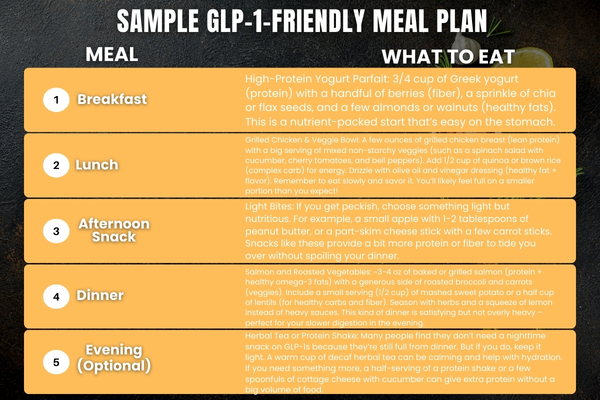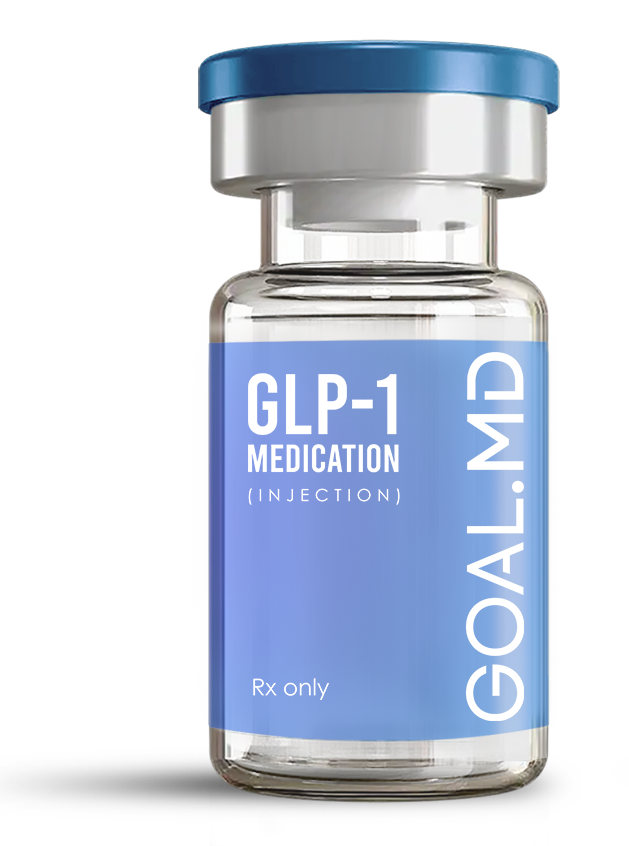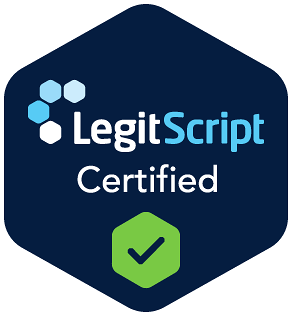
GOAL.MD Health & Wellness Blog
Evidence-based insights, medical weight loss information, and practical tips from our physicians and healthcare experts.

Eating Healthy While on GLP-1 Medications: Your Guide to Thriving with Semaglutide & Tirzepatide
Eating Healthy While on GLP-1 Medications: Your Guide to Thriving with Semaglutide & Tirzepatide
Key Takeaways:
GLP-1 medications curb your appetite: Drugs like semaglutide and tirzepatide make you feel full sooner and less hungry overall by slowing digestion , webmd.com. This helps with weight loss, but it also means you need to be mindful of getting enough nutrients in fewer calories.
Nutrient-dense foods are essential: With a smaller appetite, every bite counts. Focus on lean proteins, vegetables, fruits, and whole grains. Emphasizing protein and veggies while cutting back on added sugars and refined carbs is key for a balanced diet, according to medicalnewstoday.com.
Portion sizes and pacing matter: You’ll fill up faster than before. Start with smaller portions (about half of what you might normally serve) and eat slowly. Give yourself 15-20 minutes after eating to decide if you truly need seconds , healthline.com.
Choose foods that agree with you: Greasy, fried, or spicy foods can be harder to handle on GLP-1s, potentially worsening side effects like nausea or heartburn . Opt for gentle, high-fiber foods that support digestion (think whole grains, beans, veggies) and stay hydrated.
Support your journey with a plan: The right eating habits combined with GLP-1 medication can supercharge your results. Pair your treatment with a smart nutrition plan, and don’t hesitate to get support from healthcare professionals. (Ready to get started? Start Your Plan with GOAL.MD’s GLP-1 program is below!)
Understanding How GLP-1s Affect Your Appetite
GLP-1 medications (like Ozempic®/Wegovy® for semaglutide or Mounjaro® for tirzepatide) are well-known for reducing hunger. They work by mimicking a natural hormone that tells your body “I’m full” – so you feel satisfied with less food. You might notice that you’re not thinking about food as much, cravings diminish, and a small meal that used to leave you hungry now fills you up completely. This is a big plus for weight loss, but it’s an adjustment for your daily eating habits.
Appetite changes on GLP-1s can be empowering and a little surprising. Many people find they have to remind themselves to eat on schedule because they just don’t feel as hungry. Doctors have noted that some patients feel so little appetite they risk undereating, even to the point of malnutrition or dehydration if they aren’t careful. The goal is to take advantage of that reduced hunger for weight loss while still nourishing your body. In other words, you want to make every meal count nutritionally.
Why Healthy Eating Matters When Taking GLP-1s
Eating healthy is always important, but when you’re on a GLP-1 medication it becomes vital. Why? Because if you’re naturally eating less, you have to be strategic about what you’re eating. These medications are most effective when paired with nutritious, balanced meals webmd.com. Think of the medication as doing half the work (taming your appetite), and your food choices doing the other half (fueling your body and metabolism).
A common strategy is following a “balanced plate” approach at each meal. Since your stomach empties more slowly on GLP-1s, stuffing it with high-calorie junk food can backfire – you’ll feel uncomfortably full and miss out on essential nutrients. Instead, fill up on lean protein, fiber-rich veggies, and healthy carbs that give you steady energy. This not only helps prevent nutritional deficiencies (a risk if you’re eating significantly less) but also supports better weight loss. High-protein, high-fiber diets can help you lose fat while preserving muscle – crucial for keeping your metabolism humming along. Plus, a balanced diet will work with the medication to keep your blood sugar stable and digestion smooth, whereas things like sugary drinks or fried foods might work against it by causing sugar spikes or GI upset.
Smart Eating Strategies for GLP-1 Success
Every individual is a little different, but these healthy eating strategies are a great starting point if you’re on semaglutide, tirzepatide, or similar GLP-1 treatments:
Prioritize Protein at Every Meal: Protein is your best friend on GLP-1s. Since you can’t eat large volumes, make sure the first things you eat are protein-rich (eggs, Greek yogurt, chicken, fish, tofu, beans). This helps maintain your muscle mass and keeps you full longer. Aim to include at least a palm-sized portion of lean protein in meals. If you fill up quickly, at least you got your protein in first!
Fill Half Your Plate with Veggies: Non-starchy vegetables are high in nutrients and fiber but low in calories – perfect for maximizing nutrition when you’re eating less. Leafy greens, broccoli, cauliflower, peppers, cucumbers, zucchini, etc. add bulk to your meal without weighing you down. The fiber helps your digestion and feeds healthy gut bacteria, which is extra helpful since GLP-1s slow your digestion. Plus, veggies help prevent constipation and keep you satisfied.
Include Healthy Carbs (in Smaller Portions): Carbs are not the enemy; you just want quality over quantity. Opt for high-fiber, slow-burning carbs like whole grains (brown rice, quinoa, whole wheat bread), starchy vegetables (sweet potato, squash), or legumes (beans, lentils). These give you energy and additional fiber. Keep the portion moderate – about a quarter of your plate – to avoid overly large meals. Whole grains and beans also provide resistant starch and prebiotic fiber, which support digestion and even help your body’s GLP-1 response.
Don’t Forget Healthy Fats: A little fat is important for nutrient absorption and satiety. Use small servings of healthy fats like olive or avocado oil, nuts, seeds, avocado, or fatty fish. For example, drizzle olive oil on your salad or add a few slices of avocado. Fats are calorie-dense, so you don’t need a lot – just enough to round out the meal and keep you satisfied.
Eat Slowly and Mindfully: Old habits like rushing through meals can cause discomfort now. Take your time when eating. Chew thoroughly and pause often. Since GLP-1s are making your stomach empty slowly, eating too quickly might make you uncomfortably full before your brain registers it. By eating mindfully, you’ll tune into those fullness signals. A good trick is to eat half of what’s on your plate, then wait 10-15 minutes. You’ll often find that you’re already satisfied. If not, you can continue with a few more bites.
Small, Frequent Meals if Needed: There’s no one-size-fits-all, but many people on GLP-1s prefer smaller meals or snacks spaced out throughout the day. For instance, you might have a modest breakfast, a mid-morning protein snack, a lunch, an afternoon yogurt, and then dinner. Smaller portions put less stress on your slowed digestion and can help with any nausea. Find a pattern that gives you energy and meets your protein goals without making you feel overstuffed.
Stay Hydrated: Drinking enough fluids is important, especially since eating less food also means you’re getting less water from food. Sip water regularly throughout the day. If plain water is tough on your stomach, try herbal teas, water with a splash of lemon, or broth. Hydration helps digestion and can prevent headaches or fatigue that sometimes occur if you’re eating much less than before. (Bonus: Soups can be a great way to get nutrition + hydration in one go – broth-based soups with veggies and protein are gentle on the stomach and filling.)
Watch Out for Trigger Foods: Pay attention to foods that don’t sit well with your stomach now. Common culprits are fried or greasy foods, very spicy dishes, and high-sugar treats. On GLP-1s, fatty and fried foods can worsen nausea or reflux for some. Extremely spicy meals might be harder to handle too. Sugary desserts or drinks not only add empty calories but can spike your blood sugar, counteracting the medication’s benefits. You don’t have to swear off your favorite foods forever, but moderation is key. For example, if you want a cheeseburger, maybe have half of one and see how you feel instead of a double bacon cheeseburger with fries. Balance is everything!
Listen to Your Body’s Cues: One amazing thing about GLP-1 therapy is that it can help you truly listen to hunger and fullness signals. Take advantage of this. Eat when you’re hungry (not just bored or stressed), and stop when you feel comfortably full, even if there’s food left. Some days you might barely feel hungry at all – still aim to eat a little something wholesome at regular intervals to keep your blood sugar steady and nutrients coming in. On other days, especially if you’ve been more active, you might feel hungrier – focus on fueling up with healthy choices. By honoring your body’s signals, you’ll develop a more mindful relationship with food that lasts beyond the medication.
GLP-1 Healthy Plate: Aim for 50% non-starchy veggies, 25% lean protein, and 25% high-fiber carbs at each meal. Adding a small portion of healthy fats (like olive oil, nuts, or avocado) for flavor and satiety is encouraged. This balanced plate approach ensures you get plenty of nutrients and fiber even with smaller meals library.teladochealth.com. It can help prevent nutrient gaps and keep you full and energized, all while working synergistically with your GLP-1 medication for weight loss. Remember, a balanced meal like this will digest more slowly (thanks to protein and fiber), keeping you satisfied longer and minimizing blood-sugar spikes.

To put it all together, here’s an example of a day of GLP-1-friendly meals. Everyone’s tastes and dietary needs are different, but this sample day shows how you can structure balanced, smaller meals that nourish you and keep you comfortable:

This meal plan is just an illustration – you can mix and match foods you enjoy. The key is balance: every meal has protein, veggies or fruit, and some healthy carbs, with a little good fat. Notice that the portions are modest. On GLP-1s, that modest amount will likely feel like plenty. By planning meals this way, you’re feeding your body well without overeating. Feel free to adjust portion sizes based on your hunger signals; some days you might eat a bit more, and other days a bit less. The beauty of GLP-1 medications is that they help you naturally regulate how much you eat, so you can focus on making sure what you eat is nutritious and satisfying.
Ready to Start Your Plan?
Making smart food choices while on a GLP-1 medication can transform your weight loss journey – and you don’t have to do it alone. If you’re looking for guidance or a structured program to follow, consider teaming up with the experts. Start Your Plan with GOAL.MD’s GLP-1 weight loss program to get personalized support every step of the way. Our physician-guided plans are designed to maximize the benefits of medications like semaglutide and tirzepatide while keeping you feeling your best. With medical expertise, nutrition coaching, and a community behind you, you’ll have all the tools you need to succeed. (Visit our GLP-1 program page to learn more and take the first step toward your goals!)
You’ve Got This!
Embarking on a healthier eating plan with the help of GLP-1 medication is a positive change – and every small step counts. Remember, it’s not about perfection, but consistency. Celebrate those wins like choosing a high-protein breakfast or noticing you’re comfortably full on a smaller meal. Be patient with yourself on harder days; your appetite signals are adjusting and you’re learning new habits. With each nutritious meal, you’re giving your body the fuel it needs to lose weight safely and feel great. Trust the process, listen to your body, and lean on support when you need it. You’re on the path to a healthier you, and we’re cheering you on all the way!
즐겨찾기 (Happy healthy eating!) 🚀
Why GOAL.MD?
✅ Sourced from audited 503a US compounding pharmacies.
✅ Custom dosages adjusted to your needs.
✅ Free consultation + 24/7 support.

How It Works
1. Quiz
90 seconds. No commitment.
2. Consult
Video chat with your GOAL.MD doctor.
3. Deliver
Meds at your door tomorrow.
Transform Your Life with Physician-Directed Care
Join thousands who've found success with physician-directed care. Take our 3-minute quiz to see if medical weight loss is right for you.







